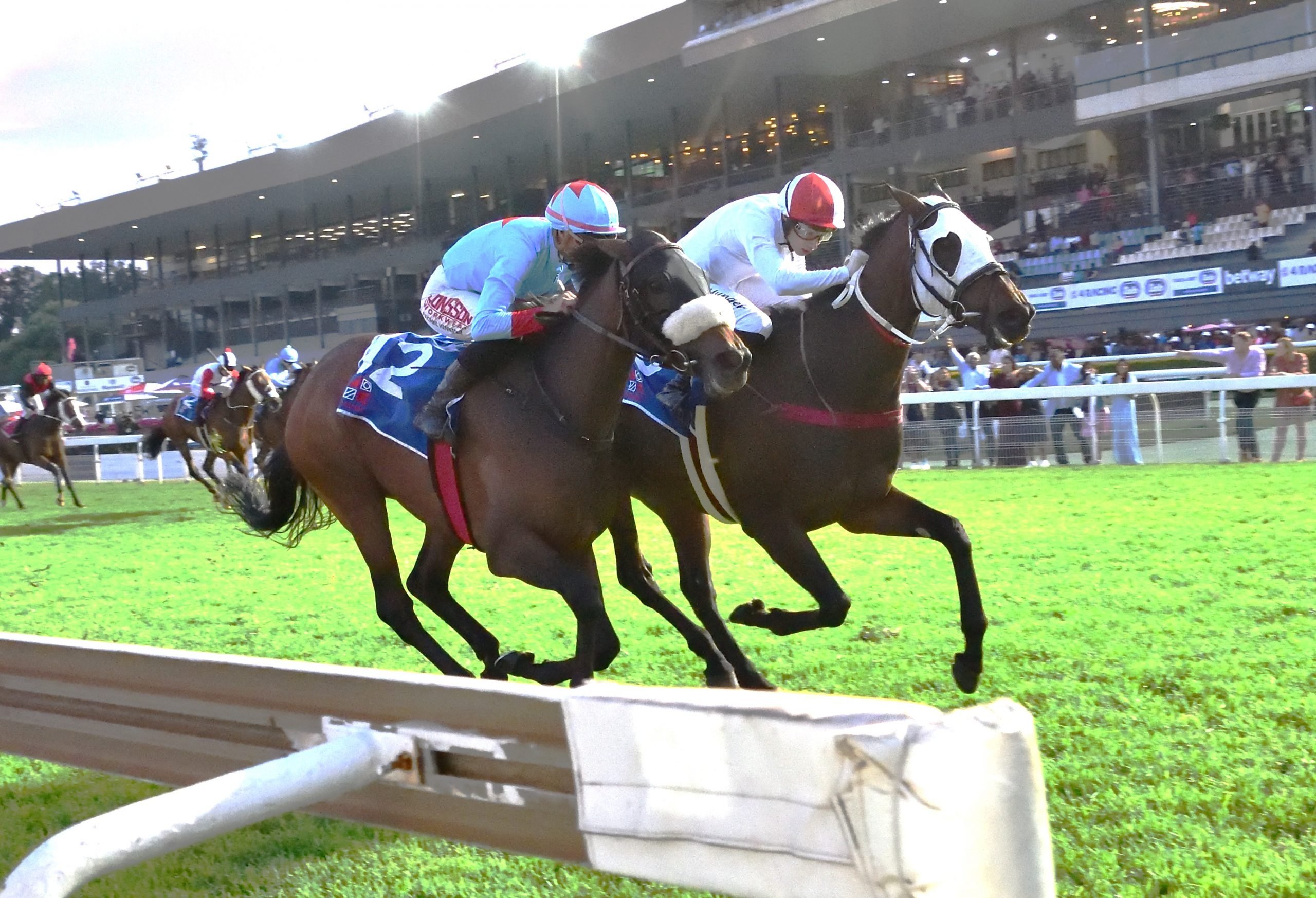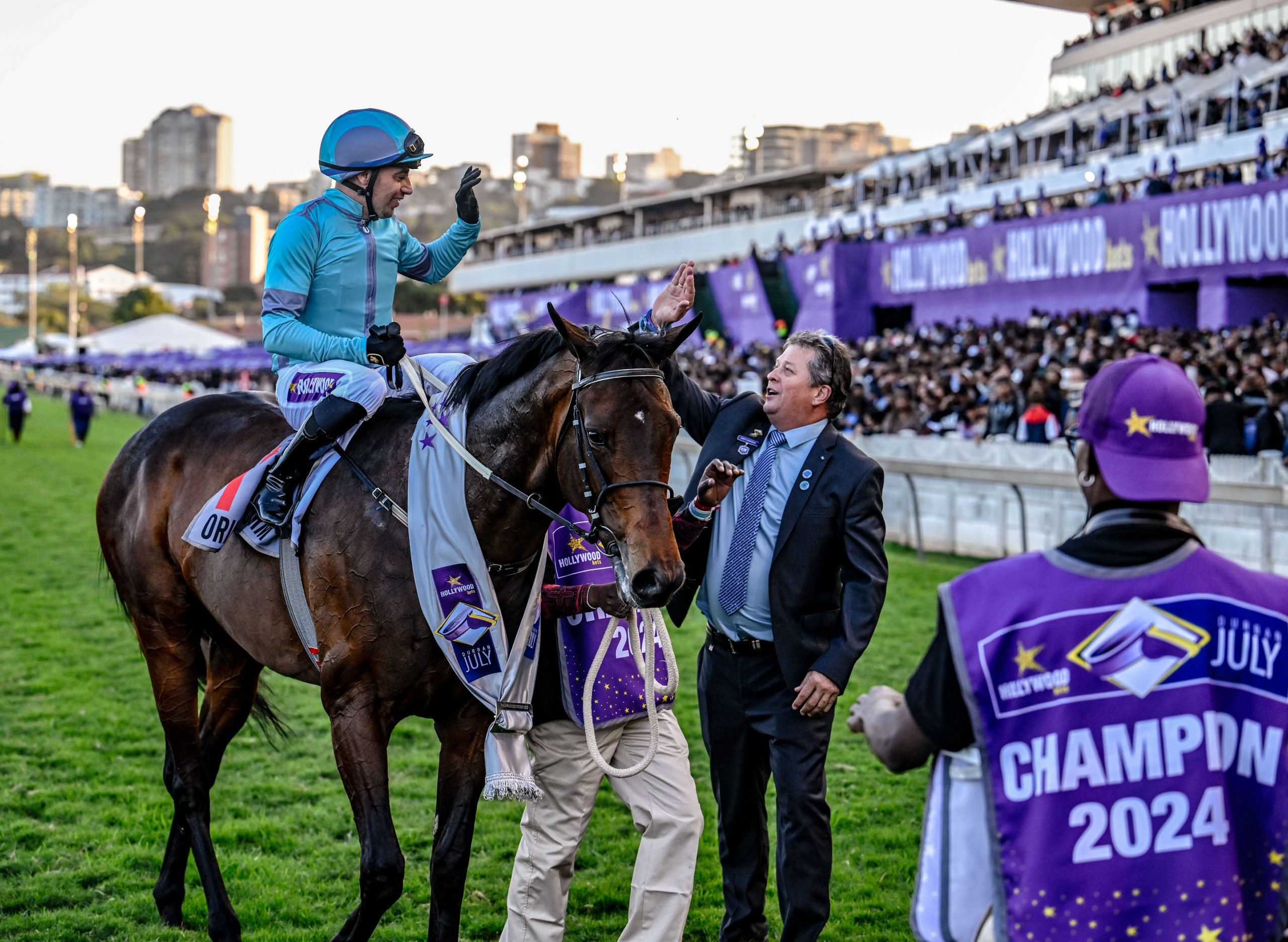When Charles Dickens won the 163rd renewal of the R2m L’Ormarins King’s Plate (Gr.1) on Saturday, it was the 187th Stakes Win and 23rd Gr.1 win for Drakenstein’s famous Champion Foundation Sire Trippi (USA), writes Robin Bruss.
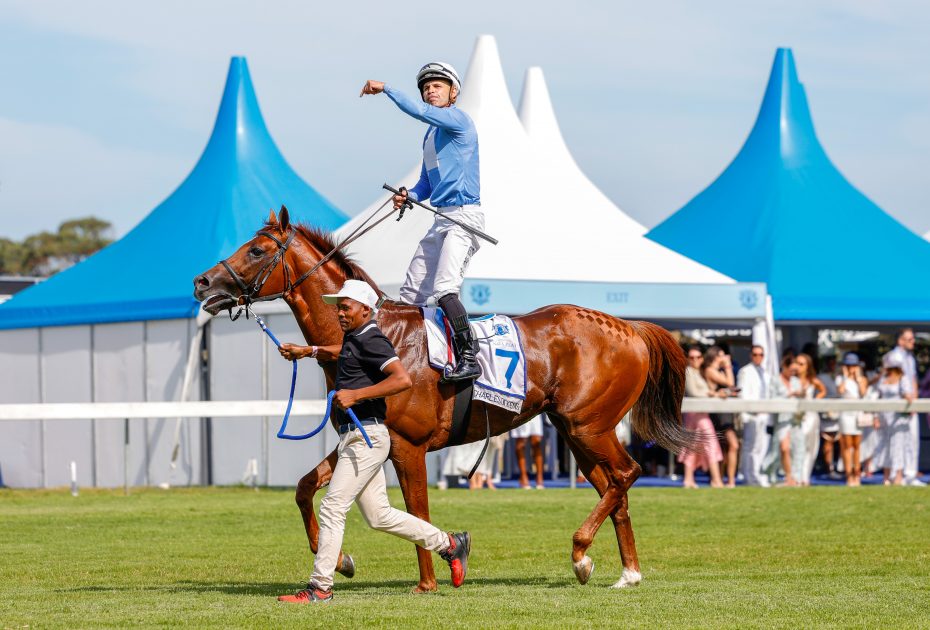
All hail the King! Charles Dickens (Aldo Domeyer) (Pic – Candiese Lenferna)
Whilst Gaynor Rupert and her Drakenstein team celebrated their first victory as an owner in South Africa’s Mile Championship following almost 20 years of their own sponsorship of the landmark race, it wasn’t lost on breeders that this was the third victory for sons of Trippi in the past four years, for he also sired Jet Dark to win in 2021 and 2022 when, prior to the death of Queen Elizabeth II, the race was known as the L’Ormarins Queen’s Plate Gr.1.
Jet Dark (2017) won 9 races in 19 starts, including five Gr.1 Wins, and had lifetime earnings of R5,697,850.
Charles Dickens (2019) has 10 wins so far in 13 starts, including three Gr.1 Wins and R5,119,813.
Jet Dark ended his career on a Merit Rating of 130. Charles Dickens is currently on 132.
It may be arguable whether Charles Dickens or Jet Dark is the best of Trippi’s progeny, a moot point perhaps because both of them were bred at Drakenstein and both will stand at Drakenstein.
Jet Dark was sold by Drakenstein for R200,000 at the 2019 National Yearling Sales (where the top price was R9 million!) to the bid of astute Nic Jonsson.
In 2023, Jet Dark retired to his home paddocks to cover his first book comprising 134 mares. Charles Dickens is destined to do the same when his racing career is eventually completed.
Jet Dark was out of a mare by Jet Master, who also won the Queens Plate Gr.1 twice, back in 1999 and 2000, yet another indication what a breed shaping race it has become.
Jet Master achieved six sire championships in South Africa and sired the gelding Pocket Power, who won the Queens Plate 4 times (2006 to 2010).
The L’Ormarins King’s Plate Gr.1 as a breed shaping race
The history of the race bears the names of many great horses, we pick out dual winner Black Cap and Royal Affair in the Fifties, Sea Cottage won it twice in the 1960s, and William Penn in 1969.
Yatahan, Sledgehammer, Politician (twice) were greats in the 1970s, memorable wins by Foveros (GB) and Wolf Power (twice) in the 1980s; Flaming Rock (Ire), London News and the ‘galloping goldmine’ Empress Club (Arg) in the 1990s; Pocket Power’s four wins dominated the first decade of the new millennium, the breed shaping broodmare Mother Russia established a new race record in 2011, and then Gimmethegreenlight (Aus) won in 2011.
The gelding Legal Eagle then won three times, Do It Again won as a 3 year old and subsequent successful sires Cape Town Noir and Futura in the following years, until we come to the domination of Drakenstein Stud breds winning in 3 of the past 4 years.
Apart from Jet Master’s six Sire Championships, Foveros (GB) also achieved six Sire Championships in South Africa – and Gimmethegreenlight (Aus) has dominated the General Sires List in two of the past 3 years.
Charles Dickens and Jet Dark sit in esteemed company.
Trippi (USA) is in second place as the most prolific sire of Kings Plate Gr.1 winners with three so far, and only behind the Champion Sire Fairthorn (GB) (1942) who sired four winners who won the race 5 times in all: (Sea Cottage twice, Inverthorn, Muscovite, Fair Weather) back in the 1950s and 1960s.
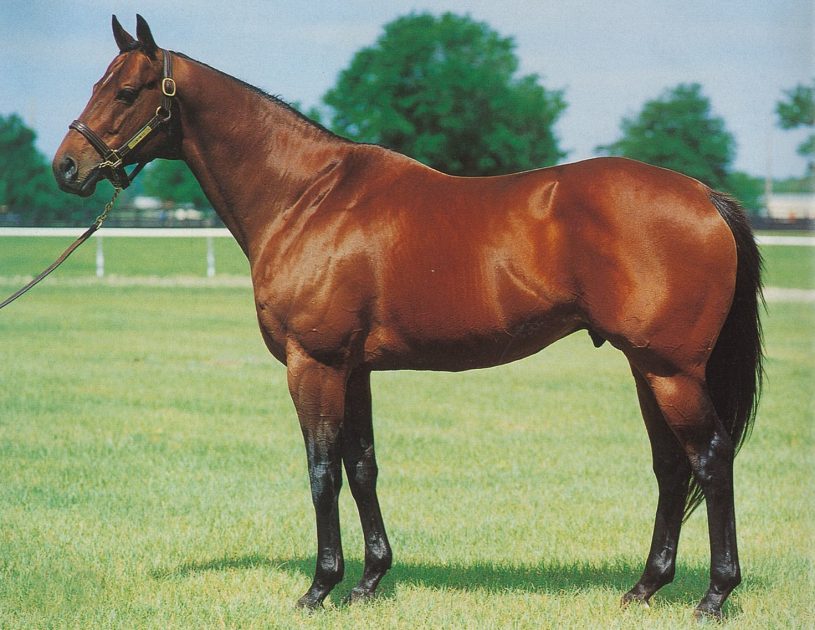
End Sweep – sire of Trippi (Pic – supplied)
Before leaving the King’s Plate, it’s noteworthy to look at race times and winning margins just out of interest:
Charles Dicken’s late great storming acceleration was reminiscent of Sea Cottage’s amazing burst in 1962, although Charles Dickens won by 2,75 lengths to Sea Cottage’s ¾ length, and Charles recorded a faster time.
Wolf Power won by the same margin as Charles, but his time was a full second slower.
Jet Master won by 3,25 lengths in 0,2 secs faster than Charles Dickens; Gimmethegreenlight almost identical time, but won in a photo finish.
William Penn, Yataghan, Sledgehammer, Politician and Foveros were all more than a second slower.
Charles Dickens career has a way to go before he concludes, but it’s safe to say that he will be amongst the greats of the turf and he and Jet Dark will be worthy successors to their sire Trippi, in what Gaynor Rupert noted in her victory speech on Saturday as “the future of Drakenstein stud”.
Trippi as a Racehorse
Trippi (born 1997) was a $65,000 two year old purchase by the founder of American racing syndicates, Cot Campbell’s Dogwood Farm, and he was trained by Hall of Fame trainer Todd Pletcher and ridden in almost all of his races by another Hall of Famer, jockey Jerry Bailey.
Trippi was named by Campbell after the All American star footballer, Charley Trippi, who turned 100 years old in 2022.
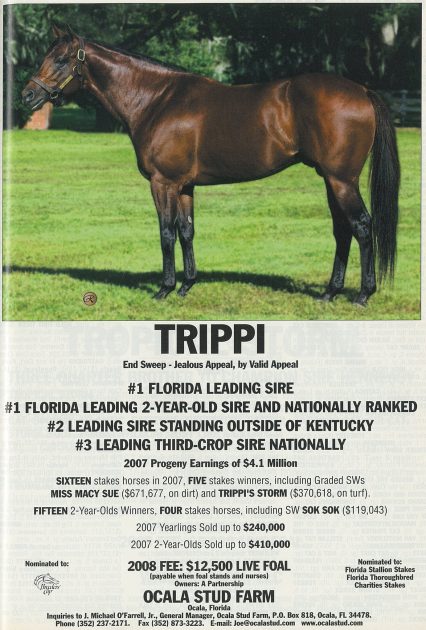
In his memoirs, Cot Campell wrote that the racehorse Trippi was “a real gentleman whose character could be seen in his lovely head and big generous eye”.
“Could he ever scorch the earth!” Campbell declared.
“In his races, he would break a half-length behind the field. But the next three strides would find him two lengths on top, and chances are he would never look back. He had this blinding speed.”
Bucked shins prevented Trippi starting as a 2 year old. However he soared home by 5 lengths on his debut over 6 furlongs in January of his 3 year old career in Florida.
A month later he ran over 7 furlongs and won by 9 lengths, then announced himself as a Kentucky Derby contender with an easy win over 7 furlongs in the Swale S. (Gr.3) in March.
He was odds on when winning April’s Flamingo S. (Gr.3) over a mile and came to the first Saturday of May and the 10f Kentucky Derby as an unbeaten horse, third favourite behind Fusaichi Pegasus and More Than Ready.
The 10 furlongs of the Kentucky Derby proved a distance too far and Trippi faded in the final furlong after being in the speed duel upfront, and he finished 11th, with Fusaichi Pegasus winning and More Than Ready finishing 4th.
A month later in June, Trippi was dropped back to 7 furlongs and won the Riva Ridge S. (Gr.2) at Belmont Park in New York by an impressive 8 lengths. In July he coasted home by 5 lengths in the Tom Fool S. (Gr.2) at Belmont against older horses to make it 6 wins in 7 starts in 7 months.
A racehorse’s job is to race and Todd Pletcher had a tough, sound, brilliant racing machine on his hands. So in August, it was in the 6f Amsterdam S. (Gr.3) as the 5/10 hot favourite, but by now he was over the top and ran only third to a 12/1 outsider.
No problem as it was the prep run for September’s Gr.1 sprint champion race in New York, the famed Vosburgh S. (Gr.1) at Belmont Park over 7f, and here Trippi had to meet his stablemate, the outstanding Gr.1 Winner More Than Ready, later to become one of the world’s great sires, (amongst his future progeny, Gimmethegreenlight!).
According to The Bloodhorse, “After watching his stars More Than Ready and Trippi knock heads with the best 3 Year Olds in America all year, Todd Pletcher’s big goal was to make each Gr.1 Winners and possibly, one of them the Eclipse Champion Sprinter”.
They would have to take each other on in September’s Vosburgh Gr.1 as a prelude to the November 2000 Breeders Cup Sprint Championship Gr.1.
Trippi broke alertly, went straight to the lead, whilst More Than Ready was hampered at the start and had to come on late. In the end Trippi prevailed by ½ length over his stablemate in 1 min 21.6 secs for the 7f in a result which didn’t quite define who was the better of the two brilliant star sprinters. It was More Than Ready’s first sprint defeat of his career, whilst Trippi remained unbeaten at 7f.
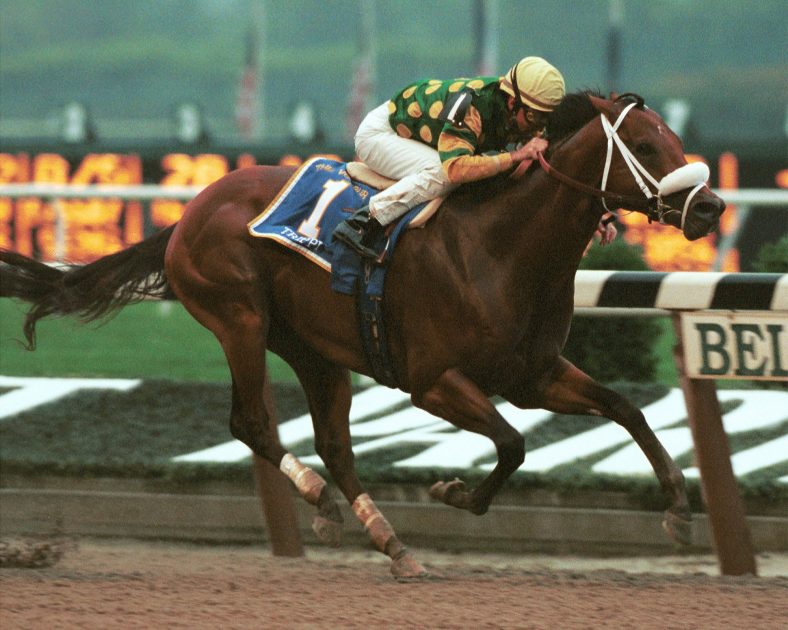
Trippi wins the 2000 Vosburgh S (Gr1) over 7f at Belmont Park defeating More Than Ready (Pic – Supplied)
“It’s tough when you have two horses that you like so much and have so much respect for ” said Pletcher, “because of the way these two go out and give 120 percent every time. You hate to see either get beaten!”.
As things turned out, next up neither ran a place in a very rough run Breeders Cup Sprint Gr.1 over 6 furlongs, won by the grand old gelding Kona Gold (30 starts, 14 wins, $2,2m), with More Than Ready bumped and forced 8 wide to finish 5th and Trippi, hampered on his inside draw, no clear run and finished 9th.
It cost Trippi the champion sprint title, but luckily for South Africa as he would likely never have arrived here had he won.
As a 4 year old, Trippi was plagued by a foot problem and ran 4 times without winning, and retired with 7 wins in 14 starts and $666,220 in earnings. He was sold to stand at Michael O’Farrel’s Ocala Stud Farm in Florida at an initial fee of $7,500.
Trippi as a Stallion in America
Trippi’s attraction to Florida lay in his sire End Sweep, a Gr.3 winning son of the Met Mile Gr1 winner Forty Niner, by Mr Prospector, who had stood in Florida to sensational results before being sold to Japan in 2000.
End Sweep’s first crop had raced in 1998 and he set an American record for 2 year old winners with 48 juvenile runners, of which 33 won and 8 others placed.
He was looking like another version of his own legendary sire Mr Prospector, who had started his stud career on the same farm.
In 1999, , just 3 crops in, End Sweep was bought by Japan’s Yoshida family for their Shadai Stud with southern hemisphere shuttling rights to Arrowfield Stud in Australia.
Trippi was born in End Sweep’s second crop. Sadly, End Sweep stood only 5 seasons in Japan before he died at the young age of 12.
In all, he sired 600 winners from 728 runners – a remarkable 82% winners to runners -a feat emulated by Trippi who has 838 winners from 1030 runners so far, which is 81,3% winners to runners!
This then is a testament to soundness and consistency of the line.
I also attribute these traits to Trippi’s dam Jealous Appeal, who raced 18 times and bred 7 runners, 7 winners of which four were Stakes winners and won 15 Stakes races between them, tough, sound and durable campaigners.
She was by Valid Appeal (36 starts) from Jealous Cat (26 starts) by the Chilean bred Cougar II (50 starts, 20 wins including 18 Stakes, tough as teak and achieved Hall of Fame status in the USA).
End Sweep sired altogether 47 Stakes Winners (6,4% of Runners), whereas Trippi has sired 92 Stakes Winners so far (8,9% of runners). The 100 SW mark might yet be achieved by career end.
End Sweep’s Gr.1 Winners include Japanese champion Admire Moon (out of a Sunday Silence mare), who won the 2400m Japan Cup Gr.1, and the 1800m Dubai Duty Free Gr.1, and is now a successful sire.
End Sweep also sired Swept Overboard, a gelding who won the Met Mile Gr.1 in New York, Trippi who won the Vosburgh Gr.1 over 7f, and four Gr.1 winning fillies.
Mostly, like the Mr Prospector line will do, the progeny of Trippi are sprinter milers, and occasionally, there are some that can extend their brilliant speed to 2000m and beyond.
Like his sire, Trippi’s first Florida crop, born in 2003, was a big success. He sired 17 individual juvenile winners in the first crop, putting him into the Top 10 Sires of Two Year Olds in America.
In his second crop he had 21 juvenile winners and 4 Stakes Winners and his fee jumped up to $12,500. By his 3rd crop he was the Champion Sire in Florida in both the General Sires List and Champion Two Year Old Sires List. He was the 2nd leading sire standing outside of Kentucky and the 3rd Leading Third Crop Sire in America.
In Crop 2, he had sired Miss Macy Sue, who was to win 11 of her 25 starts over 5f to 6f and $880,915, amongst them 6 stakes races. Brilliantly fast as she was, Miss Macy Sue’s legacy for Trippi has been her success as Florida’s Broodmare of the Year.
She produced two star horses, now both Kentucky stallion successes in Liam’s Map and Not This Time.
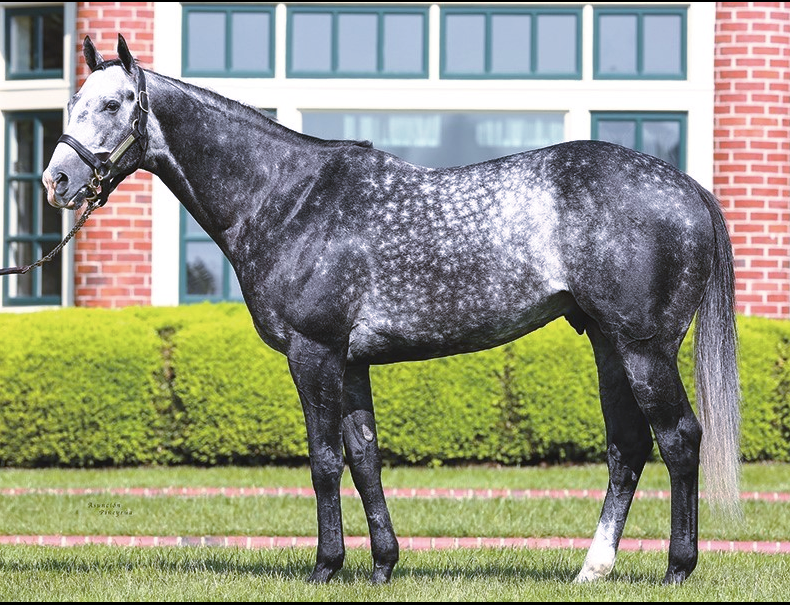
Liam’s Map, by Unbridled’s Song – Miss Macy Sue by Trippi, stands for $40,000 stud fee (Pic – Supplied)
Liam’s Map won the 2015 Breeders Cup Dirt Mile Gr.1 and $1,358,000 and stands at Lanes End Farm in Kentucky, where has so far sired four Gr.1 winners in his first three crops.
Not This Time only raced at 2 years, winning a Gr.3 and was 2nd in the 2016 Breeders Cup Juvenile S. Gr.1, and starting at a lowly $10,000 stud fee, he has sired 5 individual Gr.1 winners in his first 3 crops, including the USA Champion 3 Year Old 2022 Epicentre and is now one of the hottest young sires in the world.
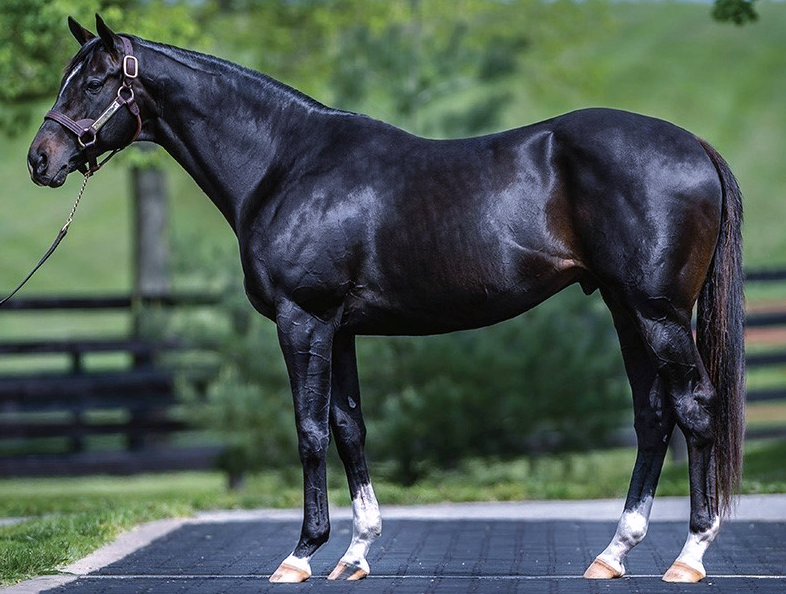
Not This Time, by Giants Causeway – Miss Macy Sue by Trippi, stands for $150,000 stud fee (Pic – Supplied)
By 2008, Trippi had three crops racing, he had established himself in Florida as the leading young sire, but was now vulnerable to purchase by a smart breeder, willing to recognise his quality and to strike and buy him.
That breeder was Gaynor Rupert and how and why it happened as well as the analysis of Trippi’s championship success in South Africa becomes Part 2 of this story, to be continued next week.








